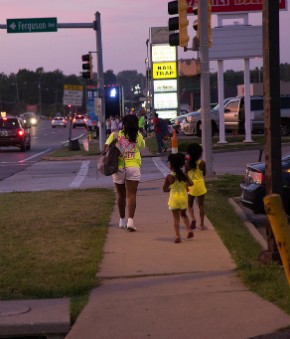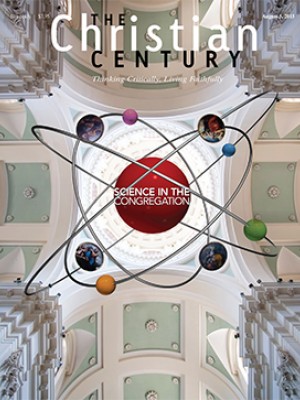Aftershock: A church on the front lines in Ferguson

The events that focused national attention on Ferguson, Missouri, a year ago were disruptive and at times confusing for St. Peter’s United Church of Christ. Our church, which is about 20 percent African American, is located about one mile away from where an unarmed black man, Michael Brown, was shot to death August 9, 2014, by police officer Darren Wilson. Our building didn’t suffer any damage, but some of the businesses damaged during three nights of violence were only two blocks north of the church.
St. Peter’s has a long tradition of service. It houses a free medical clinic and opens its gymnasium to the neighborhood each Wednesday afternoon during the school year. It provides space for adult education classes, collects food for a local pantry, and addresses issues of parenting and child abuse. It hosts musical concerts and sponsors a small theater group, and these performances are given free to the community. We are in the process of constructing a community center at a cost of $850,000 to house these ministries and other nonprofit groups.
Read our latest issue or browse back issues.
The congregation’s commitment to mission was challenged by the demonstrations, however, and it had to recognize diverse opinions among members on how to respond. Some members became so agitated and demoralized by the protests and violence that they sought counseling, with symptoms similar to those of traumatic stress. One leader was so upset by events that he resigned his church position so as to be free to voice his personal opinions.
Some members supported the conscientious law officers, while others wanted more focus on unjust police and municipal actions. Some wondered why more low-income people had not registered to vote in order to elect leaders sympathetic to their cause. As a congregation, we asked, “Should our church become a sanctuary for the demonstrators or a defender of the good that is already here in our community?” Should we place “I love Ferguson” signs in our yard or signs saying “Hands up, don’t shoot”? We had requests for both.
As a pastor, I wondered whether worship should be an occasion for teaching about the issues facing those brutalized by the justice system, or the one hour of the week when folks did not have to confront the smoke and the fires and the angry faces they saw on TV. How could we maintain a sense of partnership and loving care for one another while having different opinions?
The six full-time staff members disagreed among themselves about what the church could or should do. One person wanted us to show more sympathy for the demonstrators, while others wished that all demonstrators would be arrested, no matter what they did. We struggled with learning how to support each other amid these differences.
When people in the congregation would refer to “those demonstrators” or even “those thugs,” I tried to remind them of the wide range of people that were involved, including (1) residents of the low-income neighborhoods who were demanding fairer treatment, better schools, and honest courts; (2) religious leaders who were demonstrating for justice, even though they did not live near Ferguson (we later learned that members of our own denomination came to St. Louis primarily to participate in the demonstrations yet never contacted our congregation); (3) members and pastors whose primary goal was to help keep peace and protect the vulnerable; (4) people from outside the area who were seeking social change; (5) those seeking to take advantage of the opportunity to loot and burn; and (6) those who, as the St. Louis Post-Dispatch reported, simply wanted to disrupt civic life and who attacked police officers and even hacked into the police and city hall computer systems, impeding the work of ambulance and fire crews.
Over the past months, we’ve seen some government and police practices change. The municipal judge, city manager, court clerk, and police chief have all resigned. Municipal courts have been taken over by the state supreme court, and efforts are under way in the state legislature to consolidate courts and provide more fairness in sentencing. Limits have been put on the percentage of municipal budgets that can be raised from traffic violations and fines. There are significantly fewer “speed traps,” and citizens with unpaid traffic fines no longer face the threat of incarceration. An election added two African Americans to the city council.
The community has been working hard to support the businesses that were torched, looted, or damaged by the demonstrations. Several of the properties that could not be salvaged have been demolished and the lots cleaned of debris. Much new public charity income has been allocated to the northern portion of St. Louis County. Organizations reaching youth have moved some of their programs into the damaged neighborhoods. Municipalities that have often been forgotten have received help from organizations like the county mental health commission and United Way. The governor of Missouri has appointed a special commission to address racial discrimination in the St. Louis metropolitan area. Two of the commission members are clergy from the United Church of Christ.
At St. Peter’s, a recent congregational meeting showed that people are no longer fearful about bringing up the pain of last year’s experience. But anxiety over the deeper issues of racism and poverty remains. It is likely that we will find some way to ritualize the one-year anniversary in August. We may use the occasion to take down the prayer flags that were mailed to our congregation by the children at a United Church of Christ in Asheville, North Carolina. We have been blessed by their thoughtful gesture; now we are ready to move on.
In the end, the difficulties of the past year made us more committed to our mission. We have our differences, but we are even more aware that our reason for being on this site is to care for the needy, welcome the marginalized, and work for justice for all.





